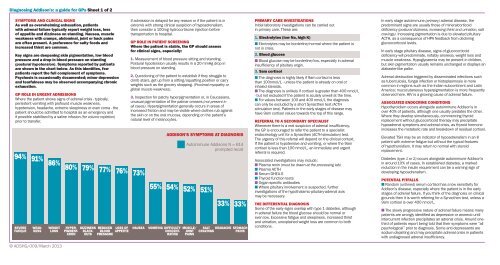Diagnosing Addison's - Addison's Disease Self Help Group
Diagnosing Addison's - Addison's Disease Self Help Group
Diagnosing Addison's - Addison's Disease Self Help Group
Create successful ePaper yourself
Turn your PDF publications into a flip-book with our unique Google optimized e-Paper software.
<strong>Diagnosing</strong> Addison’s: a guide for GPs Sheet 1 of 2Symptoms and clinical signsAs well as overwhelming exhaustion, patientswith adrenal failure typically report weight loss, lossof appetite and dizziness on standing. Nausea, muscleweakness with cramps, abdominal, joint or back painsare often present. A preference for salty foods andincreased thirst are common.Key signs are deepening skin pigmentation, low bloodpressure and a drop in blood pressure on standing(postural hypotension). Symptoms reported by patientsare shown in the chart below. As this identifies, fewpatients report the full complement of symptoms.Psychosis is occasionally documented; minor depressionand tearfulness may be observed accompanying chronicexhaustion.GP role in urgent admissionsWhere the patient shows signs of adrenal crisis - typically,persistent vomiting with profound muscle weakness,hypotension, headache, extreme sleepiness or even coma - thepatient should be admitted to hospital as an emergency andif possible stabilised by a saline infusion (for volume repletion)prior to transfer.94% 91% 86% 80% 79% 77% 76% 73%SevereFatiquehyperpigmentationweaknessweightloss© ADSHG/009/March 2013dizzinessblackoutsreducedbloodpressureloss ofappetiteIf admission is delayed for any reason or if the patient is inextremis with strong clinical suspicion of hypoadrenalism,then consider a 100mg hydrocortisone injection beforetransportation to hospital.GP role in patient screeningWhere the patient is stable, the GP should assessfor clinical signs, especially:1. Measurement of blood pressure sitting and standing.Postural hypotension usually results in a 20 mmHg drop inblood pressure on standing.2. Questioning of the patient to establish if they struggle toclimb stairs, get up from a sitting/squatting position or carryweights such as the grocery shopping. (Proximal myopathy orglobal muscle weakness).3. Inspection for patchy hyperpigmentation or, in Caucasians,unusual pigmentation of the palmar creases (not present inall cases). Hyperpigmentation generally occurs in areas ofincreased friction and may be visible where clothes rub againstthe skin or on the oral mucosa, depending on the patient’snatural level of melanocytes.nauseavomitingAddison’s symptoms at diagnosis55% 54% 52% 51%difficultyconcentratingAutoimmune Addisons N = 614prompted recallmuscle/jointpainssaltcravings33% 33%headachestomachpainsPrimary care investigationsInitial laboratory investigations can be carried outin primary care. These are:1. Electrolytes (low Na, high K)n Electrolytes may be borderline/normal where the patient isnot in crisis.2. Blood glucosen Blood glucose may be borderline/low, especially in adrenalinsufficiency of pituitary origin.3. 9am cortisoln The diagnosis is highly likely if 9am cortisol is lessthan 100nmol/L - unless the patient is already on oral orinhaled steroids.n The diagnosis is unlikely if cortisol is greater than 400 nmol/L- but not excluded if the patient is acutely unwell at the time.n For values between 100 and 400 nmol/L the diagnosiscan only be excluded by a short Synacthen test (ACTHstimulation test). Patients in the early stages of disease mayhave 9am cortisol values towards the top of this range.Referral to a secondary specialistWhenever there is a real suspicion of adrenal insufficiency,the GP is encouraged to refer the patient to a specialistendocrinology unit for a Synacthen (ACTH stimulation) test.The urgency of this referral will depend on the clinical context.If the patient is hypotensive and vomiting, or where the 9amcortisol is less than 100 nmol/L, an immediate and urgentreferral is required.Associated investigations may include:n Plasma renin (must be drawn at the processing lab)n Plasma ACTHn Serum DHEA-Sn Thyroid function testsn Organ-specific antibodiesn Where pituitary involvement is suspected, furtherinvestigations of the hypothalamic-pituitary-adrenal axismay be necessary.The differential diagnosisSome of the early signs overlap with type 1 diabetes, althoughin adrenal failure the blood glucose should be normal oreven low. Excessive fatigue and sleepiness, increased thirstand urination, unexplained weight loss are common to bothconditions.In early stage autoimmune (primary) adrenal disease, thepredominant signs are usually those of mineralcorticoiddeficiency (postural dizziness, increasing thirst and urination, saltcravings). Increasing pigmentation is due to elevated pituitaryACTH, as a consequence of HPA feedback from decliningglucoocorticoid levels.In early stage pituitary disease, signs of glucocorticoiddeficiency will predominate, notably anorexia, weight loss andmuscle weakness. Hypoglycaemia may be present in children,but skin pigmentation usually remains unchanged or displays analabaster-like pallor.Adrenal destruction triggered by disseminated infections suchas tuberculosis, fungal infection or histoplasmosis is morecommon in regions such as the Indian subcontinent and LatinAmerica; mucocutaneous hyperpigmentation is more frequentlyobserved here. HIV is a growing cause of adrenal failure.Associated endocrine conditionsHypothyroidism occurs alongside autoimmune Addison’s inover 40% of patients, although one usually predates the other.Where they develop simultaneously, commencing thyroidreplacement without glucocorticoid therapy may precipitatehypoadrenal symptoms and adrenal crisis, as thyroid hormoneincreases the metabolic rate and breakdown of residual cortisol.Elevated TSH may be an indicator of hypoadrenalism in an illpatient with extreme fatigue but without the typical featuresof hypothyroidism. It may return to normal with steroidreplacement.Diabetes (type 1 or 2) occurs alongside autoimmune Addison’sin around 10% of cases. In established diabetes, a markedreduction in the insulin requirement can be a warning sign ofdeveloping hypoadrenalism.Potential pitfallsn Random (untimed) serum cortisol has a low sensitivity forAddison’s disease, especially where the patient is in the earlystages of adrenal failure. If you think of the diagnosis on clinicalgrounds then it is worth referring for a Synacthen test, unless a9am cortisol is over 400 nmol/L.n The slowly progressive nature of adrenal failure means manypatients are wrongly identified as depressive or anorexic untilintercurrent infection precipitates an adrenal crisis. Around onethirdof patients report being told that their symptoms were “allpsychological” prior to diagnosis. Some anti-depressants aresodium-depleting and may precipitate adrenal crisis in patientswith undiagnosed adrenal insufficiency.







